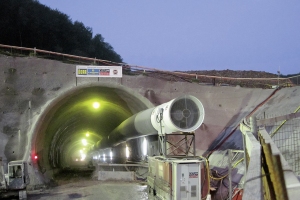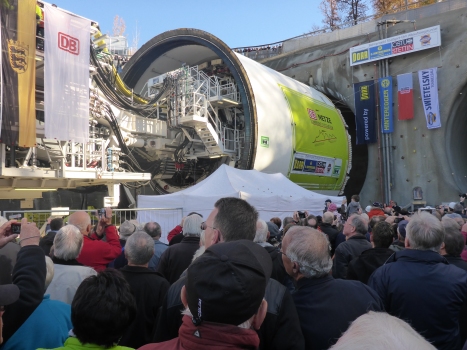General Information
| Name in local language: | Boßlertunnel |
|---|---|
| Beginning of works: | 2013 |
| Completion: | December 2022 |
| Status: | under construction |
Project Type
| Structure: |
Tunnel with segmental lining |
|---|---|
| Function / usage: |
High-speed rail tunnel |
| Construction method: |
Tunnel boring machine (TBM) |
Location
| Location: |
Aichelberg, Göppingen (Kreis), Baden-Württemberg, Germany Mühlhausen im Täle, Göppingen (Kreis), Baden-Württemberg, Germany |
|---|---|
| Part of: |
|
| Coordinates: | 48° 37' 49.70" N 9° 33' 50.30" E |
| Coordinates: | 48° 34' 20.80" N 9° 38' 41.60" E |
Technical Information
Dimensions
| tunnel length | 8 806 m |
Case Studies and Applied Products

The Albaufstieg: Tunnel construction for high speed rail line
The Stuttgart-Ulm railway project includes several major projects that will shift traffic from the roads to the rails. The existing, winding rail line south-east of Stuttgart over the Swabian Alb only allows ... [more]
Excerpt from Wikipedia
The Boßler Tunnel is a railway tunnel currently under construction as part of the new Wendlingen–Ulm high-speed railway. The tunnel is approximately 8,806 metres (28,891 ft) long, built as two parallel single-track tunnels. The tunnel runs between Aichelberg and Mühlhausen im Täle under the Roter Wasen and the Boßler mountain. It is one of a series of tunnels underneath the Swabian Jura range. When completed, it will be the longest tunnel on the line and the fifth longest tunnel in Germany (after the Landrücken Tunnel, the Münden Tunnel, the Filder Tunnel and the Katzenberg Tunnel).
Route
The tunnel runs in a straight line towards the southeast, passing under the Roter Wasen and the Boßler. The tunnel climbs about 213 metres (699 ft) to the southeast portal, with a gradient of about 25% (1 in 40). The maximum overburden depth is 280 metres (920 ft).
History
Deciding between alternative routes
The tunnel is part of the Albaufstieg section of the line (track section 2.2), which involves an ascent of the Swabian Jura (also known in German as the Alb). 25 alternative routes were initially considered for this section. A plan drawn up in 1993 included an 8-kilometre (5.0 mi) tunnel. A later, 1995 plan included an 8,710-metre (28,580 ft) tunnel. Many alternative routes were considered for the Aichelberg to Widderstall corridor. As well as routes involving a combined rail and motorway tunnel and a direct route, local variations of the route in the Neidlingen, Wiesensteig and Westerheim districts were also considered.
The spatial planning provisions required to consider possible alternative routes for the Albaufstieg. Eight different routes were examined in detail. In 1999 a hydrological evaluation of these variants was conducted. After a planning stop in 2000, a new integrated assessment was carried out in 2006 in the context of paths for combined traffic routes. In the middle of 1991 an early road design proposed the beginning of the tunnel already in Weilheim an der Teck. while a length of 9 km was allotted for this part of Albaufstieg. According to the planning status of 1993, an 8.8 km long tunnel was provided in this area.
As of 2004 and 2007, the planned length was 8710 m. Plans of 2007 envisaged the building of an exploratory tunnel within the cross-section of the later final tunnel due to the prevalent geological conditions.
In mid-August 2009, the consultation process for the 14.5 km long zoning section Albaufstieg to which the tunnel belongs, was completed by the regional council of Stuttgart and handed over to the Federal Railway Authority for final approval. In the process leading to approval, 82 public agencies were consulted, and 1150 private reservations were handled. The principal resulting changes affected the site logistics. In mid-2009, construction work was scheduled to start in 2010.
Dispute on use of tunnel boring machines
Due to the unstable rock, planning decisions initially ruled out the use of tunnel boring machines. However, according to entrepreneur Martin Herrenknecht their use could save 70 to 100 million euros over the originally tendered conventional method The company obtained expert opinion at their own cost, and thus achieved the approval of mechanical tunneling. Together with the excavation of Filder tunnel, 80 to 100 million euros could thus been saved. A 2830 m long section was advanced using tunnel boring machines (TBM) in both tubes. Although Deutsche Bahn had stipulated conventional shotcrete tunneling in the tender documents, alternative proposals had been welcomed for TBM excavation. This had proven itself an economic solution.
Award of contract
On 8 November 2011, the tunnel shell of Boßler- and Steinbühltunnel was advertised throughout Europe. Construction of Boßlertunnels was subdivided into two lots of approximately 3670 and approximately 5100 m in length; the Steinbühltunnel forms a third, independent lot. Moreover, to be utilized in the course of the contract, among other things some 1.32 million cubic meters of excavated material or disposed of and built four makeshift connection points on the Autobahn 8.
The calculation documents were sent to bidders in February 2012. The contract was awarded in October 2012 together with that for the Steinbühltunnel. The cost for both tunnels at 635 million euros, according to the web significantly below the planned cost Ursprünglich wurde mit der Vergabe erst Ende 2012 gerechnet (Stand: Dezember 2011). Die Vergabe wurde Ende November 2012 offiziell bekanntgemacht. was originally expected the award until the end of 2012 (December 2011). Die Vergabe wurde Ende November 2012 offiziell bekanntgemacht. The award was the end of November 2012 officially published. The total cost for both the tunnel Albaufstiegs specified end of October 2013, about 1.05 billion euros. For the full planning approval section 2.4, the price level of 2010 1,074.3 million euros estimated. At the conclusion of the financing agreement of the new line in April 2009 was calculated for the Boßler Tunnel with shell costs of around EUR 19.5 million per kilometer and tube. When applying for financial construction permit in 2010, the planned cost was €32.0 million per kilometer and tube.
Construction
Beginning in December 2012, the clearing work for site at portal Aichelberg began. 2013 should be a dam between the bridge, it has already been completed on the country road 1214. The bridge was completed the first building of the new line in 2011 In early 2012 it was planned to begin after the Site investigation to propel mid-2013 The excavation at 'intermediate attack Umpfental' 'began in July 2013. 66 months are provided for the shell. The two tubes should be first built in NATM. To accelerate the construction of three intermediate points were provided. As part of a plan amendment process an intermediate attack in 2008 was rejected. The planning of 2009 provides another intermediate attack in the form of a window tunnel before, which is to be filled in again after completion of the tunneling the 920 . m long ' 'between attack Umpfental' 'hits 5230 m from the west portal located on the driving tunnel. From there should be provided 2830 m falling and 3576 m ascending (to the east portal). From West Portal machines propulsion was on a length of 2830 m. At a propulsion from the eastern portal was due to the very steep flanks and environmental considerations omitted. By mid-November 2014, 600 meters of intermediate attack were propelled.
Of the 8,772 m long west tube to 8,745 m in mined construction arise, the remaining 27 m are provided for portal structures. Of the 8,788 m long east tunnel are 8,761 m in mining techniques and also 27. m at the portals open cut provided Together with the Steinbühltunnel should a total of 4.3 million cubic meters of material to be excavated. The machine propulsion should, according to the planning status of the end of 2013, beginning not later than September 21, 2014.
Approximately 8,000 people attended on November 8, 2014 Construction Site Open Day. Machine propulsion began symbolically. The actual start of driving should be made in January 2015
After that had overburden proved more solid than initially planned, in 2014, an extended machine propulsion was considered. Possibly the tunnel can be completely pushed forward with the machine Spätestens am 8. Dezember 2014 wurde der konventionelle Vortrieb ohne Angabe von Gründen gestoppt. Dabei waren bergabwärts 731 m und bergaufwärts bei 47 m. At the latest on 8 December 2014, the conventional propulsion without cause was stopped. It was downhill 731 m and uphill at 47 m The according to other sources for before Christmas in 2014 announced propelling start was delayed, according to web information indefinitely due to necessary fine adjustments to the machine
End in February 2015 announced the Bundesbahn its intention to extend the machinery propelling Early March 2015 ran talks between German railway and contractors on the extension of mechanical tunneling Among other things, due to lack of permits, the start of driving delayed to the end four months
The machine propulsion finally began on April 14, 2015. The 120 meter long, 11.38. m high and about 29 million euros expensive machine is called S 833 and was given the name Kätchen. It was planned to achieve a propulsion power of 15 to 20 meters per day. The machine excavation of the first tube to take eight to nine months to complete. Subsequently, to be disassembled and the cutting out transport from the tube, the shield skin is to remain in the mountain. After one kilometer machines propulsion resulted unexpected, very dry rock dust exposure The machines propulsion reached instead of the planned 20 meters per day in some cases more than 30 meters. In July and August 2015 rested the propulsion for five weeks in order to convert the logistics for a higher driving speed. On August 5, 2015, the advance was resumed early September 2015 were with the machine 1.6 propelled km
Parts of the tunnel's outer layer (German: Tübbinge) were made in a Tübbingwerk in Weilheim, seven days a week, in two shifts per day with 100 workers each. The 1.6 km long way to the tunnel portal is to be covered with a Feldbahn.
On November 6, 2016 the machine finished the first tube. The structural work was provided in mid-2013 in 2018 The finishing of the tunnel will be November 2019.
Geology
For about six kilometres, the tunnel passes beneath Middle Jurassic layers. Preliminary investigations had shown very low strength in some sections, thus unstable rock is expected in connection with an overburden of up to 280 m. Furthermore, Karst formations are expected in the White Jurassic layers. The Middle Jurassic layers consist of claystone and argillaceous marl with sandstone inclusions. From top to bottom, the layers α, β (unstable rock), and γ - ξ are traversed, followed by White Jurassic α, β, and γ. The water pressure in the Middle Jurassic layers is expected to reach 4 bar (400 kPa), in the White Jurassic up to 10 bar (1,000 kPa).
Text imported from Wikipedia article "Boßler Tunnel" and modified on 14 August 2020 according to the CC-BY-SA 3.0 license.
Participants
Relevant Web Sites
Relevant Publications
- (2017): Der Boßlertunnel - optimiert im Bauprozess. The Boßler Tunnel - an optimised construction process. In: DETAIL structure, v. 3, n. 2 (October 2017), pp. 48-53.
- (2018): Breakthrough a Stoccarda. In: Strade e Autostrade, v. 22, n. 131 (September 2018), pp. 80-81.
- (2016): ICE sulle Schwäbische Alb. In: Strade e Autostrade, v. 20, n. 116 (March 2016), pp. 76-80.
- (2004): Neubaustrecke Wendlingen-Ulm. Die Filstalbrücke als Teil des "Albaufstiegs". In: [ Umrisse ], v. 4, n. 2 ( 2004), pp. 13-17.
- About this
data sheet - Structure-ID
20012212 - Published on:
25/05/2004 - Last updated on:
28/05/2021





